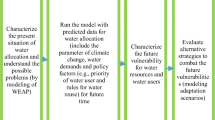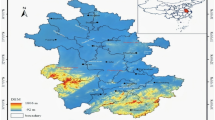Abstract
Based on numerical weather prediction model Weather Research and Forecasting (WRF) and Hydrologic Modeling System (HEC-HMS), a coupling model is constructed in Taihang Piedmont basin. The WRF model parameter scheme combinations composed of microphysics, planetary boundary layers, and cumulus parameterizations suitable for the study area are optimized. In both time and space, we tested the effects of the WRF model by a multi-index evaluation system composed of relative error, root meantime square error, probability of detection, false alarm ratio, and critical success index and established this system in two stages. A multi-attribute decision-making model based on Technique for Order Preference by Similarity to an Ideal Solution and grey correlation degree is proposed to optimize each parameter scheme. Among 18 parameter scheme combinations, Mellor-Yamada-Janjic, Grell-Devinji, Purdue-Lin, Betts-Miller-Janjić, and Single-Moment6 are ideal choices according to the simulation performance in both time and space. Using the unidirectional coupling method, the rolling rainfall forecast results of the WRF model in the 24 h and 48 h forecast periods are input to HEC-HMS hydrological model to simulate three typical floods. The coupling simulation results are better than the traditional forecast method, and it prolongs the flood forecast period of the Taihang Piedmont basin.










Similar content being viewed by others
Data availability
The data that support the fundings of this study are available from the corresponding author upon request.
Code availability
Not applicable.
References
Abushandi E, Merkel B (2013) Modelling rainfall runoff relations using HEC-HMS and IHACRES for a single rain event in an arid region of Jordan. Water Resour Manage 27(7):2391–2409
Anderson M, Chen Z, Kavvas M et al (2002) Coupling HEC-HMS with atmospheric models for prediction of watershed runoff. J Hydrol Eng 7(4):312–318
Cheng X, Zhang Q (2012) Analysis of climate change trend in Xingtai City in recent 57 years. J Anhui Agr Sci 40(02):978–980
Cheng H, Wang Y, Wen B et al (2019) Reliability analysis of rain and snow weather diagnosis in Kelan area, Shanxi Province Based on NCEP FNL data. J Meteorol Environ 35(02):23–31
Ding Y, Li H, Shao A (2019) Simulation of 2m temperature and precipitation in Qinba Mountain area based on different parametric scheme combinations of WRF model. Gansu Sci Technol 35(09):39–43+46
Evans JP, Ekström M, Ji F (2012) Evaluating the performance of a WRF physics ensemble over South-East Australia. Clim Dyn 39(6):1241–1258
Feldman AD (2000) Hydrologic modeling system HEC-HMS: technical reference manual. US Army Corps of Engineers, Hydrologic Engineering Center
Fiedler F (2003) Simple, practical method for determining station weights using Thiessen polygons and isohyetal maps. J Hydrol Eng 4(8):219–221
Fleming M, Scharffenberg W (2012) Hydrologic Modeling System (HEC-HMS): new features for urban hydrology, USACE Hydrologic Engineering Center, Davis
Flesch TK, Reuter GW (2012) WRF model simulation of two Alberta flooding events and the impact of topography. J Hydrometeorol 13(2):695–708
Grell GA, Freitas SR (2014) A scale and aerosol aware stochastic convective parameterization for weather and air quality modeling. Atmos Chem Phys 14(10):5233–5250
Gyawali R, Watkins DW (2012) Continuous hydrologic modeling of snow-affected watersheds in the Great Lakes basin using HEC-HMS. J Hydrol Eng 18(1):29–39
Hwang C, Yoon K (1981) Multiple attribute decision making. Springer, Berlin, Heidelberg, p 269
Janjic Z (1994) The step-mountain eta coordinate model: further developments of the convection, viscous sublayer, and turbulence closure schemes. Mon Wea Rev 122(5):927–945
Janjic Z (2000) Comments on development and evaluation of a convection scheme for use in climate models. J Atmos Sci 57(21):3686–3686
Jasper K, Kaufmann P (2003) Coupled runoff simulations as validation tools for atmospheric models at the regional scale. Q J R Meteorol Soc 129(588):673–692
Kain J (2004) The Kain-Fritsch convective parameterization: an update. J Appl Meteorol 43(1):170–181
Knebl MR, Yang ZL, Hutchison K et al (2005) Regional scale flood modeling using NEXRAD rainfall, GIS, and HEC-HMS/RAS: a case study for the San Antonio River Basin Summer 2002 storm event. J Environ Manage 75(4):325–336
Li L, Jin J, Zhu Y (2012) Discussion on some problems in the application of the TOPSIS method. Water Resour Power 30(3):51–54
Li A, He H, Zhang Y (2012) Numerical simulation of the influence of land surface parameter disturbance of WRF model on a rainstorm in Northwest China. Plateau Meteorol 31(1):65–75
Li J, Chen Y, Wang H et al (2017) Extending flood forecasting lead time in a large watershed by coupling WRF QPF with a distributed hydrological model. Hydrol Earth Syst Sci 21(2):1279–1294
Lin Y, Farley RD, Orville HD (1983) Bulk parameterization of the snow field in a cloud model. J Climate Appl Meteorol 22(6):1065–1092
Lin C, Wen L, Lu G et al (2006) Atmospheric-hydrological modeling of severe precipitation and floods in the Huaihe River Basin. Chin J Hydrol 330(1–2):249–259
Liu S, Cai H, Yang Y et al (2013) Advance in grey incidence analysis modeling. Syst Eng-Theor Prac 33(08):2041–2046
Liu H, Wu J, Chen X et al (2020) Analysis of grey correlation degree between water resources system and socio-economic system. Trop Geomorphol 41(01):31–36
Meili J (2021) Sustainable agriculture and food production in Qinghai: analysis based on grey correlation model. IOP Conf Ser Earth Environ Sci 831(1):12040
Niu J (2007) Influence of different microphysical parameterization schemes on the forecast of heavy rainfall, M.S.thesis, Academy of Meteorological Science, China, p 87 (in Chinese)
Pennelly C, Reuter G, Flesch T (2014) Verification of the WRF model for simulating heavy precipitation in Alberta. Atmos Res 135–136:172–192
Qi P (2019) Study on microphysical characteristics and precipitation formation mechanism of cumulus mixed cloud in the eastern foot of Taihang Mountain, M.S. thesis, Chinese Academy of Meteorological Science, China, p 69 (in Chinese)
Tang C, Dennis RL (2014) How reliable is the offline linkage of Weather Research & Forecasting model (WRF) and variable infiltration capacity (VIC) model? Global Planet Change 116:1–9
Tian J, Liu J, Wang J et al (2017) A spatio-temporal evaluation of the WRF physical parameterisations for numerical rainfall simulation in semi-humid and semi-arid catchments of Northern China. Atmos Res 191:141–155
Vincendon B, Ducrocq V, Dierer S et al (2009) Flash flood forecasting within the PREVIEW project: value of high-resolution hydrometeorological coupled forecast. Meteorol Atmos Phys 103(1–4):115–125
Wang C, Wang B (2021) Analysis of the influencing factors of the zero drift of capacitive acceleration sensor based on grey correlation degree. Int Core J Eng 8(7):191–202
Wang Z, Duan A, Wu G (2014) Effects of boundary layer parameterization scheme and air-sea coupling on WRF simulation of East Asian summer monsoon. Sci China Earth Sci 44(03):548–562
Wang R, Qiao F, Ding Y et al (2021) Impact of cumulus parameterization schemes with multigrid nesting on the high-resolution simulation of an extreme heavy rainfall event in Chongming. Shanghai Clim Environ Res 26(01):58–74
Wang Y (2018) Research on coupled atmosphere-hydrologic modeling for hydrologic simulation in watersheds based on different grids sizes, Ph.D. thesis, China Institute of Water Resources and Hydropower Research, p 158 (in Chinese)
Xu Y, Zhang W, Liu Y (2004) Research on standardization of decision matrix in multi-attribute decision making. In: China Youth Conference of operations research and management scholars, Qinhuangdao, China (in Chinese)
Yan Z, Deng LT (2007) Description of microphysical processes in WRF model and its prediction experiment. Desert Oasis Meteorol 06:1–6
Yang B, Zhang Y, Qian Y (2012) Simulation of urban climate with high-resolution WRF model: a case study in Nanjing. Chin Asia-Pac J Atmos Sci 48(3):227–241
Yu Z, Lakhtakia MN, Yarnal B et al (1999) Simulating the river-basin response to atmospheric forcing by linking a mesoscale meteorological model and hydrologic model system. J Hydrol 218(1–2):72–91
Zhang S, Sun K, Zhang H et al (2013) Impact from the microphysical scheme of WRF model on the simulation of a heavy rainfall process in Shanxi Province. Water Resour Hydropower Eng 44(9):8–11
Zhou J, Ouyang S, Wang X et al (2014) Multi-objective parameter calibration and multi-attribute decision-making: an application to conceptual hydrological model calibration. Water Resour Manage 28(3):767–783
Acknowledgements
Thanks to the National Natural Science Foundation of China and all authors for their contributions.
Funding
This work was supported by the National Natural Science Foundation of China (No. 52079086) and State Key Laboratory of Hydraulic Engineering Intelligent Construction and Operation (Grant No. HESS-2309).
Author information
Authors and Affiliations
Contributions
Ting Zhang: manuscript writing. Ya Gao: data trend analysis. Ping Yu: material preparation, data collection, and analysis. Jianzhu Li: data collection, and analysis. Ping Feng: supervision and editing. Huixin Ma: data gathering.
Corresponding author
Ethics declarations
Ethics approval
Not applicable.
Consent to participate
Not applicable.
Consent for publication
Not applicable.
Competing interests
The authors declare no competing interests.
Additional information
Publisher's Note
Springer Nature remains neutral with regard to jurisdictional claims in published maps and institutional affiliations.
Rights and permissions
Springer Nature or its licensor (e.g. a society or other partner) holds exclusive rights to this article under a publishing agreement with the author(s) or other rightsholder(s); author self-archiving of the accepted manuscript version of this article is solely governed by the terms of such publishing agreement and applicable law.
About this article
Cite this article
Zhang, T., Gao, Y., Yu, P. et al. Improving flood forecasts capability of Taihang Piedmont basin by optimizing WRF parameter combination and coupling with HEC-HMS. Theor Appl Climatol 155, 3647–3665 (2024). https://doi.org/10.1007/s00704-024-04836-7
Received:
Accepted:
Published:
Issue Date:
DOI: https://doi.org/10.1007/s00704-024-04836-7




